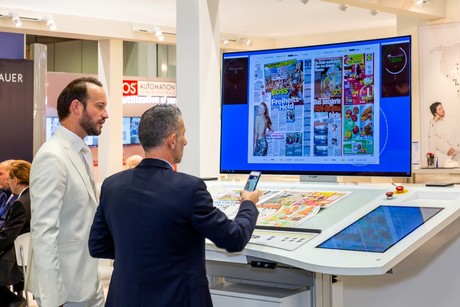Why should a newspaper publisher or printer consider investing in digital printing today? And what is your business vision for digital printing in the newspaper sector?
The newspaper industry is going through a huge transformation. Undoubtedly the biggest driver in all of this has been the internet and e-content. For publishers this means that their customers are changing their habits and are accessing content in different ways. The most significant knock on effect of these changes has been that newspapers have lost millions of dollars of advertising revenues as brands and enterprises find new ways to engage with their customer audiences, moving away from traditional page advertising, meaning that newspaper publishers need to cut costs or find new revenue streams to survive. These are the same drivers for many industries going through transformation. Cut costs and increase revenues. Digital print has a huge role to play in achieving both of those goals for newspaper publishers. Cost reduction in bringing content to market can be achieved with shorter run production (in line with reduced demand) reducing waste and unnecessary cost. Decentralized production can be done closer to the market reducing shipment and logistical costs. A great example of this would be ex-pat newspapers produced in smaller quantities in the geographical location that they are required streamlining supply chain and reaching customers more cost effectively. The product also reaches the market more quickly so has an immediacy and relevancy. Up to date news rather than a 48 hour lag. A real life example of this would be CSQ, who are one of HP’s customers based in Brescia, Italy, that produce short run Russian language newspapers using an HP T200 Inkjet Web Press
Looking at the opportunity for newspaper publishers to increase revenue streams and replace some of the millions of dollars lost from advertising revenues digital print opens up the ability to create more localised, versioned, relevant newspaper editions. A world of micro publishing and micro advertising. In some geographies where newspapers are sold on a subscription basis you have the ability to engage with your customers and understand their preferences to ensure content is relevant. Even for newsstand distribution models publishers can create content relevant to local markets and geographies. Hyper local editions of newspapers with editorial content specific to the region and also advertising content relevant to the area. Go back to our earlier example of locally produced ex-pat newspapers. There is no reason why content cannot be versioned/tailored to that geography but perhaps more significantly the advertising can be local and relevant. How about local real estate advertising for that region, or offers for the local supermarket chains for that region. This kind of hyper local product enables newspaper publishers to add greater value to their advertisers and strive to reverse the slump in their advertising revenue streams again.
Newspaper printers face similar challenges. The market is changing rapidly and run lengths are dropping. Rather than simply losing revenue with reducing print volumes the printer can look to ensure content is produced efficiently in line with market demands. They can optimize production with digital print technology for the short run production. Something unique to HP in this space is our ability to print on conventional newspaper media (lightweight 45gsm papers) and using our Bonding Agent technology we can ensure high quality printed output with minimal strikethrough of the newsprint. In short digitally printed newspapers can have the same look and feel as conventionally printed newspapers ensuring the readers have the same experience. With HP inkjet printing technology printers can also open up opportunities for printing more applications beyond just newsprint. The quality achievable on today’s presses means other higher value applications are available. Examples being things like printing localised newsstand posters to go with the newspapers. This all brings opportunity for them to add value to their relationship with newspaper publishers. Or localised inserts or magazines again with hyper local content and offers. Again this is something that CSQ are achieving with their customers using the HP T200 Inkjet Web Press.
We are also seeing a trend towards our customers that own HP technology to be working within more than one industry. Short run newspaper production done overnight for local markets and then applications such as short run book production or even high volume direct mail during the day. The technology again enables new revenue streams for the printers.
The world of newspaper print is changing and will continue to change. HP as a company that focuses on how technology can transform industries will continue to drive and lead that change offering up new opportunities to both publishers and printers.



